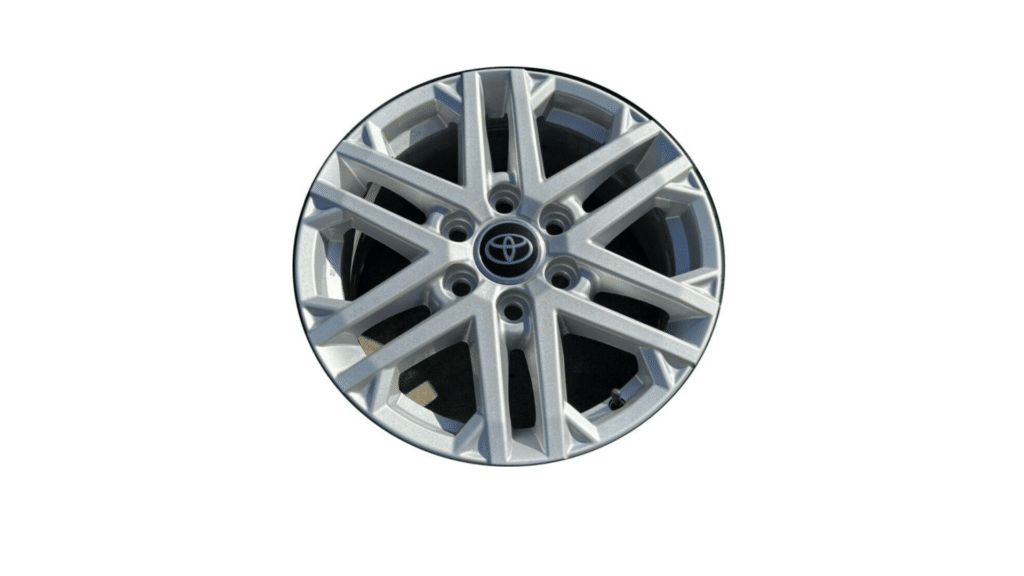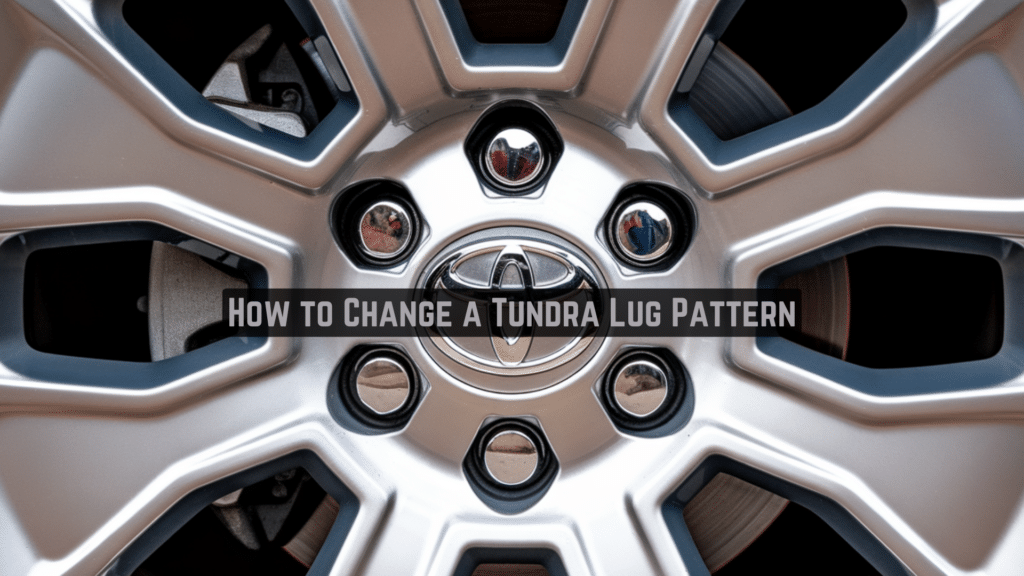Have you ever tried switching out your Tundra’s wheels only to get stuck on the lug pattern? You’re not alone. Countless Toyota owners hit this roadblock, especially when upgrading their rims or swapping between model years.
I’ve been a Toyota mechanic for 15 years, and I’ve seen every lug pattern challenge you can imagine. In this guide, I’ll walk you through everything you need to know about Tundra lug patterns.
We’ll cover all models from 2000 to 2024, including the tricky 2007 transition year.
You’ll learn exactly how to:
- Identify your current lug pattern.
- Find compatible wheels.
- Make changes safely.
No technical jargon, no confusion – just clear steps that work. By the end of this guide, you’ll handle lug pattern changes like a pro.
What Is a Lug Pattern?

Think of a lug pattern like your truck’s footprint. It’s the specific way wheel studs are arranged on your hub. Get this wrong, and your new wheels won’t fit – no matter how nice they look.
1. Here’s what you really need to know
A lug pattern has two key numbers. First is how many lugs you have. Second is the diameter of the circle they make. For example, a “6×139.7” pattern means you’ve got 6 lugs in a circle that’s 139.7mm wide.
I often tell my customers to picture a pizza. The lugs are like the toppings – they need to line up perfectly with the holes in your wheel. One wrong measurement, and you’re stuck with wheels that won’t mount.
2. On a Tundra, you’ll typically see
- 5 or 6 lug holes.
- Circle diameters of 139.7mm or 150mm.
- Variations between model years.
Got a tape measure handy? Let’s check your pattern together in the next section.
Toyota Tundra Lug Pattern by Model Year
Let me break down the lug patterns for every Tundra generation. I’ve worked on these trucks for years, and this is your go-to reference for getting it right the first time.
1. First Generation (2000-2006)
- All models: 6×139.7mm.
- Simple and consistent across all trim levels.
2. Second Generation (2007-2021)
- 2007-2021 Regular and Double Cab: 5x150mm.
- 2007-2021 CrewMax: 5x150mm.
- Note: 2007 was the transition year when Toyota switched patterns.
3. Third Generation (2022-Present)
- All 2022+ models: 5x150mm.
- All trim levels use the same pattern.
- Includes TRD Pro and Capstone editions.
4. Key Measurements
- 6×139.7mm = 6 lugs on a 5.5-inch circle.
- 5x150mm = 5 lugs on a 5.9-inch circle.
Remember: Always double-check your specific model. While these patterns are standard, some rare special editions might differ.
How to Measure a Lug Pattern
Measuring your Tundra’s lug pattern is simpler than you might think. I’ll show you two ways to do it – the pro way and the DIY way. Both work great.
1. The Pro Method
- Start at the center of any lug.
- Measure straight across to the back of the opposite lug.
- That’s your bolt circle diameter.
- Count the total number of lugs.
2. The DIY Method (When the wheel is off)
- Get a tape measure.
- Pick any lug hole.
- Measure to the center of the opposite hole.
- Multiple this by 1.05 for close accuracy.
Quick Tips:
- Always measure in millimeters for better accuracy.
- Keep your tape measure level.
- For 5-lug patterns, measure from the back of one hole to the center of the second opposite hole.
I’ve seen folks try using paper templates, but they’re often inaccurate. Stick with direct measurement – it hasn’t failed me in 15 years of working on Tundras.
Remember: If you’re stuck between 139.7mm and 150mm, your Tundra’s model year is your best clue.
Choosing the Right Wheels for Your Tundra
Let’s cut through the confusion of wheel shopping. After helping hundreds of Tundra owners upgrade their wheels, I know what matters and what doesn’t.
1. Critical Measurements
- Lug pattern. (covered above)
- Wheel diameter.
- Width.
- Offset.
- Center bore.
First, Check Your Stock Setup. Most Tundras come with either 18″ or 20″ wheels from the factory. Going smaller than stock usually won’t clear your brake calipers. Going bigger? You’ll need to think about lift kits and tire clearance.
2. Offset Matters – A Lot
Think of offset like how far your wheel sticks out. Factory Tundra wheels usually have:
- 18″ wheels: +50mm offset.
- 20″ wheels: +60mm offset.
- TRD wheels: +25mm offset.
The Center Bore is Non-Negotiable. Your Tundra needs a 106.1mm center bore. Hub-centric rings can help if the wheel’s bore is larger but never smaller.
3. Safe Aftermarket Sizes
- 17″ (some models)
- 18″ to 22″ (most common)
- Up to 24″ (requires modifications)
Skip the guesswork – let’s check your specific model in the next section.
Tips for Changing or Upgrading Wheels
I’ve seen plenty of wheel upgrades go wrong. Here’s what I’ve learned about doing it right without wasting time or money.
Before You Start
- Check your tire pressure
- Loosen lug nuts while the wheel’s on the ground
- Use jack stands – not just your jack
- Keep your old wheels until you’re sure the new ones work
Safety First: Never work under a truck supported only by a jack. I learned this lesson early in my career when a customer’s jack failed. Thankfully, the jack stands saved the day.
1. The Right Tools Make It Easy
- Torque wrench (essential)
- Socket set with wheel-specific sizes
- Jack stands rated for your truck’s weight
- Floor jack with a good lift height
2. Torque Specs Matter
- Steel wheels: 97 ft-lbs
- Aluminum wheels: 83 ft lbs
- Always torque in a star pattern
3. Common Mistakes to Avoid
- Don’t use an impact wrench for final tightening
- Skip the thread locker – it’s not needed
- Never reuse damaged lug nuts
- Don’t forget to check torque after 50 miles
Remember: Take your time with each step. Racing through a wheel change is how expensive mistakes happen.
Conclusion
Changing your Tundra’s wheels doesn’t have to be complicated. Whether you’re upgrading to larger rims or just switching out a damaged wheel, the key is knowing your truck’s specific lug pattern and taking the right measurements.
Remember that most Tundras from 2007 onwards use the 5x150mm pattern, while earlier models stick with the 6×139.7mm setup.
Take your time with the installation, follow the torque specs, and always double-check your measurements before buying new wheels.
If you’re ever unsure, start with your truck’s model year and work from there. I’ve seen too many people rush this job and end up with expensive mistakes. But follow this guide, and you’ll get it right the first time.
Your Tundra deserves that kind of care.
Frequently Asked Questions
Can I put 2022 Tundra wheels on my 2006 Tundra?
No, they won’t fit. The 2006 Tundra uses a 6×139.7mm pattern, while the 2022 models use 5x150mm. These patterns aren’t compatible, even with adapters.
Will aftermarket wheels void my warranty?
No, changing wheels alone won’t void your warranty. However, if improper wheels cause damage to other parts, those specific repairs might not be covered. Stick to the right specs to stay safe.
Do I need special lug nuts for aftermarket wheels?
Often, yes. Many aftermarket wheels require specific lug nuts based on their seat type (conical or flat). Always use the lug nuts designed for your new wheels, not your stock ones.
Can I use wheel adapters to fit different lug patterns?
While adapters exist, I don’t recommend them for daily drivers. They add complexity and potential failure points. It’s safer and more reliable to buy wheels with the correct pattern.
How do I know if my wheels are hub-centric or lug-centric?
Look at how the wheel centers on the hub. Hub-centric wheels have a center bore that fits snugly over your hub. Lug-centric wheels center using the lug nuts. Most Tundra factory wheels are hub-centric for better balance.


